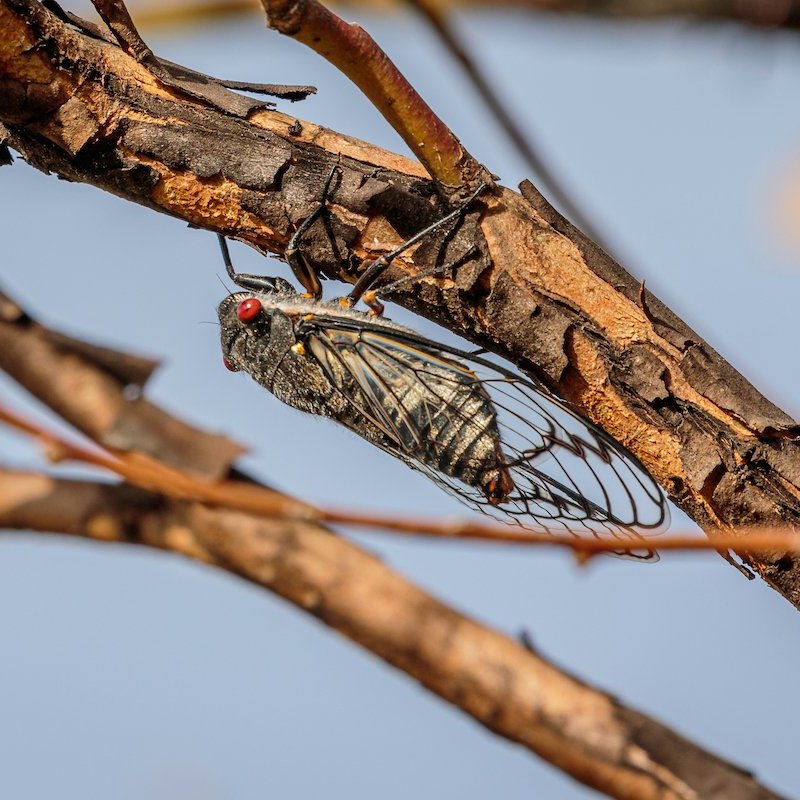
Spring is the time of year when flowers bloom, trees become green and leafy, and in some parts of the country, periodic cicadas emerge from underground. This year is expected to be a significant year for periodic cicadas too. It’s estimated that trillions of them will emerge in 15 states.
Videos by TravelAwaits
Sometime around May 13, after a warm rain, cicadas will begin to crawl out of the ground in Delaware, Georgia, Illinois, Indiana, Kentucky, Maryland, Michigan, North Carolina, New Jersey, New York, Ohio, Pennsylvania, Tennessee, Virginia, West Virginia, and Washington, D.C., a Newsweek article reports.
There can be as many as 1.5 million cicadas per acre in some parts of Maryland, so considering the size of the geographic area that will see cicada this year, there easily will be trillions of cicadas, Michael J. Raupp, emeritus professor of entomology at the University of Maryland and a fellow of the Entomological Society of America, says in an ABC 7 article. He has even referred to the event as “cicada-palooza.”
A Cicada’s Life Cycle
There are two types of cicadas. The first kind are called annual cicadas, which emerge every year and you hear in the summer. The second kind are periodical, which spend most of their lives underground and emerge every 13 or 17 years — depending on their type. Annual cicadas can be found around the world, but periodicals are only found in North America, a National Geographic article explains.
After mating, females lay eggs in a tree’s branches or twigs. In a month or two, nymphs emerge from the eggs, fall to the ground, and then burrow deep underground, a Chicago Tribune article explains.
The nymphs then spend all but a month or so of their life in an underground burrow, sucking nutrients from tree roots. Eventually, but right on cue, they climb up out of the ground. Then they molt their hard shells and fly up into trees to begin the mating season, the article continues.
A Unique Mating Call
What cicadas are perhaps best known for is the male’s mating call. Anyone who has heard cicadas wonders, “How can a little insect be so loud?”
Here’s the biology behind that feat. Cicadas have an organ called a tymbal that is key to how the males call females. The tymbal has ribs. Each time the cicada flexes his muscles, the series of ribs buckle one right after the other, and make a “clicking” noise, a Chicago Academy of Sciences’ Peggy Notebaert Nature Museum article explains.
“The action is like how a bendy straw makes sound: pulling and pushing the ribs of the bendy straw together makes a series of clicks,” the article explains. “If you could push, pull, and twist a bendy straw hundreds of times a second, the sound of the clicks would be so close together that you’d only hear a buzzing sound — this is how fast the cicada is able to vibrate its tymbal.”
The U.S. Department of Health and Human Services explains that cicadas’ mating calls can reach 90 decibels, which is “as loud as a lawnmower, dirt bike, or tractor.” The loudest cicadas’ call may be more than 100 decibels, which means it can be heard over a mile and a half away, the Peggy Notebaert Nature Museum article explains.
A Special Year
Periodical cicadas belong to 15 different broods, which all follow either a 13- or 17-year lifecycle. Making things even more confusing, some cicadas emerge exactly four years earlier than expected, a Scientific American article explains.
Broods are named with Roman numerals. This year, Brood X of the 17-year cicadas will emerge across numerous states — although some of the brood emerged early in 2017. Brood X includes three species: Magicicada septendecim species, characterized by broad orange stripes; and Magicicada cassini and Magicicada septendecula, both have almost entirely black abdomens, the Newsweek article notes.
A map showing where broods can be found as well as when they are expected to emerge can be found here.
What To Know
While cicadas are noisy and can be about two inches long, there’s nothing to fear. They don’t bite, sting, or even pinch.
For the most up-to-date news, you can find the latest here.
